Electrochemically Reduced Graphene Oxide Covalently Bound Sensor for Paracetamol Voltammetric Determination
Abstract
1. Introduction
2. Results and Discussion
2.1. Electrografting Process and Surface Fabrication
2.2. Morphological Characterization of the Modified Surface
2.3. Electrochemical Characterization of Modified Surface
2.4. Surface Area of Modified Electrodes
2.5. Electrochemical Behavior of PAR at the Modified Electrode
2.6. Effect of Experimental Variables
2.6.1. Optimization of the Electrografting Process
2.6.2. Optimization of Modified GO/NaNO2/HCl Agent
2.6.3. Optimization of Supporting Electrolyte and pH
2.7. Analytical Performance Evaluation
2.7.1. Linear Range and Limit of Detection
2.7.2. Repeatability and Reproducibility Studies
2.7.3. Excipient Analysis
2.8. Accuracy and Application in Real Samples
3. Materials and Methods
3.1. Chemicals and Materials
3.2. Instrumentation
3.3. Fabrication of Sensing Interfaces for Detection
3.4. Electrochemistry Measurement of PAR
3.5. Sample Preparation
4. Conclusions
Supplementary Materials
Author Contributions
Funding
Institutional Review Board Statement
Informed Consent Statement
Data Availability Statement
Acknowledgments
Conflicts of Interest
References
- World Health Organization (WHO). WHO Certification Scheme on the Quality of Pharmaceutical Products Moving in International Commerce: Proposed Guidelines for the Certification of Active Pharmaceutical Ingredients. 1997. Available online: https://apps.who.int/iris/handle/10665/63628 (accessed on 10 February 2025).
- Athersuch, T.J.; Antoine, D.J.; Boobis, A.R.; Coen, M.; Daly, A.K.; Possamai, L.; Nicholson, K.; Wilson, I.D. Paracetamol metabolism; hepatotoxicity, biomarkers and therapeutic interventions: A perspective. Toxicol. Res. 2018, 7, 347–357. [Google Scholar] [CrossRef] [PubMed]
- Jasani, B.; Weisz, D.E.; Mcnamara, P.J. Evidence-based use of acetaminophen for hemodynamically significant ductus arteriosus in preterm infants. Semin. Perinatol. 2018, 42, 243–252. [Google Scholar] [CrossRef]
- Rajaram, P.; Subramanian, R. Management of Acute Liver Failure in the Intensive Care Unit Setting. Clin. Liver Dis. 2018, 22, 403–408. [Google Scholar] [CrossRef]
- Mcgill, M.R.; Jaeschke, H. Expert Review of Molecular Diagnostics Biomarkers of drug-induced liver injury: Progress and utility in research, medicine, and regulation. Expert Rev. Mol. Diagn. 2018, 18, 797–807. [Google Scholar] [CrossRef] [PubMed]
- World Health Organization (WHO). WHO Guidance on Testing of “Suspect” Falsified Medicines—TRS 1010—Annex 5. 2018. Available online: https://www.who.int/publications/m/item/trs1010-annex5 (accessed on 10 February 2025).
- World Health Organization (WHO). WHO Good Practices for Pharmaceutical Quality Control Laboratories—TRS 957—Annex 1. 2010. Available online: https://www.who.int/publications/m/item/trs957-annex1 (accessed on 12 February 2025).
- World Health Organization (WHO). WHO Considerations for Requesting Analysis of Medicines Samples—TRS 1010—Annex 3; WHO Technical Report Series 1010; Annex: Manassas, VA, USA, 2018; Volume 3, pp. 179–186. Available online: https://www.who.int/publications/m/item/trs1010-annex3 (accessed on 12 February 2025).
- Kim, C.; Ryu, H.D.; Chung, E.G.; Kim, Y.; Lee, J.K. A review of analytical procedures for the simultaneous determination of medically important veterinary antibiotics in environmental water: Sample preparation, liquid chromatography, and mass spectrometry. J. Environ. Manag. 2018, 217, 629–645. [Google Scholar] [CrossRef] [PubMed]
- Mishra, S.; Singh, S.P.; Kumar, P.; Khan, M.A.; Singh, S. Emerging electrochemical portable methodologies on carbon-based electrocatalyst for the determination of pharmaceutical and pest control pollutants: State of the art. J. Environ. Chem. Eng. 2023, 11, 109023. [Google Scholar] [CrossRef]
- Satish, S.; Dey, A.; Tharmavaram, M.; Khatri, N.; Rawtani, D. Risk assessment of selected pharmaceuticals on wildlife with nanomaterials based aptasensors. Sci. Total Environ. 2022, 836, 155622. [Google Scholar] [CrossRef]
- Kurbanoglu, S.; Ozkan, S.A. Electrochemical carbon based nanosensors: A promising tool in pharmaceutical and biomedical analysis. J. Pharm. Biomed. Anal. 2018, 147, 439–457. [Google Scholar] [CrossRef]
- Megale, J.D.; De Souza, D. New approaches in antibiotics detection: The use of square wave voltammetry. J. Pharm. Biomed. Anal. 2023, 234, 115526. [Google Scholar] [CrossRef]
- Montaseri, H.; Forbes, P.B.C. Analytical techniques for the determination of acetaminophen: A review. TrAC—Trends Anal. Chem. 2018, 108, 122–134. [Google Scholar] [CrossRef]
- Gorski, W.; Electrodes, C.M.; Alkire, R.C.; Lipkowski, J.; Kolb, D.M.; Ross, P.N. (Eds.) Advances in Electrochemical Science and Engineering; Wiley-VCH John Wiley & Sons: Weinheim, Germany, 2010; p. 6274. [Google Scholar] [CrossRef]
- Boumya, W.; Taoufik, N.; Achak, M.; Barka, N. Chemically modified carbon-based electrodes for the determination of paracetamol in drugs and biological samples. J. Pharm. Anal. 2021, 11, 138–154. [Google Scholar] [CrossRef]
- Lakhera, P.; Chaudhary, V.; Jha, A.; Singh, R.; Kush, P.; Kumar, P. Recent developments and fabrication of the different electrochemical biosensors based on modified screen printed and glassy carbon electrodes for the early diagnosis of diverse breast cancer biomarkers. Mater. Today Chem. 2022, 26, 101129. [Google Scholar] [CrossRef]
- Ren, S.; Zeng, J.; Zheng, Z.; Shi, H. Perspective and application of modified electrode material technology in electrochemical voltammetric sensors for analysis and detection of illicit drugs. Sens. Actuators A Phys. 2021, 329, 112821. [Google Scholar] [CrossRef]
- Baig, N.; Sajid, M.; Saleh, T.A. Recent trends in nanomaterial-modified electrodes for electroanalytical applications. TrAC—Trends Anal. Chem. 2019, 111, 47–61. [Google Scholar] [CrossRef]
- Wang, D.; Khan, M.K.; Moloney, M.G. Diazo and diazonium compounds for surface modification. Tetrahedron Lett. 2020, 61, 151672. [Google Scholar] [CrossRef]
- Pilan, L. Tailoring the performance of electrochemical biosensors based on carbon nanomaterials via aryldiazonium electrografting. Bioelectrochemistry 2021, 138, 107697. [Google Scholar] [CrossRef]
- Pinson, J.; Podvorica, F.I. Surface modification of materials: Electrografting of organic films. Curr. Opin. Electrochem. 2020, 24, 44–48. [Google Scholar] [CrossRef]
- Morales-Martínez, D.; González, F.J. A mechanistic approach to the electrografting of carbon surfaces and electrochemical properties of the grafted films—A critical review. Electrochim. Acta 2022, 425, 140693. [Google Scholar] [CrossRef]
- Patra, S.; Roy, E.; Tiwari, A.; Madhuri, R.; Sharma, P.K. 2-Dimensional graphene as a route for emergence of additional dimension nanomaterials. Biosens. Bioelectron. 2017, 89, 8–27. [Google Scholar] [CrossRef]
- Kochmann, S. Graphene as a Sensor Material; Universitat Regensburg: Regensburg, Germany, 2013. [Google Scholar]
- Zhou, A.; Bai, J.; Hong, W.; Bai, H. Electrochemically reduced graphene oxide: Preparation, composites, and applications. Carbon 2022, 191, 301–332. [Google Scholar] [CrossRef]
- Zhang, H.; He, R.; Niu, Y.; Han, F.; Li, J.; Zhang, X.; Xu, F. Graphene-enabled wearable sensors for healthcare monitoring. Biosens. Bioelectron. 2022, 197, 113777. [Google Scholar] [CrossRef] [PubMed]
- Badillo-Ramírez, I.; Carreón, Y.J.P.; Rodríguez-Almazán, C.; Medina-Durán, C.M.; Islas, S.R.; Saniger, J.M. Graphene-Based Biosensors for Molecular Chronic Inflammatory Disease Biomarker Detection. Biosensors 2022, 12, 244. [Google Scholar] [CrossRef] [PubMed]
- Ni, S.; Qiao, L.; Shen, Z.; Gao, Y.; Liu, G. Physical absorption vs. covalent binding of graphene oxide on glassy carbon electrode towards a robust aptasensor for ratiometric electrochemical detection of vascular endothelial growth factor (VEGF) in serum. Electrochim. Acta 2020, 331, 135321. [Google Scholar] [CrossRef]
- Hetemi, D.; Noël, V.; Pinson, J. Grafting of diazonium salts on surfaces: Application to biosensors. Biosensors 2020, 10, 4. [Google Scholar] [CrossRef]
- Candia, C.P.; Imbarack, E.; Silva, C.P.; Olguín, C.F.; Jara, G.; Fuentes, S.; Zagal, J.H.; Agurto, N.; Pavez, J. Covalent modification of glassy carbon surface via radical-induced grafting from electrochemical oxidation of imine derivatives. Electrochim. Acta 2023, 459, 142544. [Google Scholar] [CrossRef]
- Li, D.; Luo, Y.; Onidas, D.; He, L.; Jin, M.; Gazeau, F.; Pinson, J.; Mangeney, C. Surface functionalization of nanomaterials by aryl diazonium salts for biomedical sciences. Adv. Colloid. Interface Sci. 2021, 294, 102479. [Google Scholar] [CrossRef]
- Mohamed, A.A.; Salmi, Z.; Dahoumane, S.A.; Mekki, A.; Carbonnier, B.; Chehimi, M.M. Functionalization of nanomaterials with aryldiazonium salts. Adv. Colloid. Interface Sci. 2015, 225, 16–36. [Google Scholar] [CrossRef]
- Borane, N.; Boddula, R.; Odedara, N.; Singh, J.; Andhe, M.; Patel, R. Comprehensive review on synthetic methods and functionalization of graphene oxide: Emerging Applications. Nano-Struct. Nano-Objects 2024, 39, 101282. [Google Scholar] [CrossRef]
- Gautier, C.; López, I.; Breton, T. A post-functionalization toolbox for diazonium (electro)-grafted surfaces: Review of the coupling methods. Mater. Adv. 2021, 2, 2773–2810. [Google Scholar] [CrossRef]
- Alam, M.A. Graphene based electrochemical biosensors for the detection of cardiac biomarkers. Biosens. Bioelectron. X 2024, 20, 100515. [Google Scholar] [CrossRef]
- Devi, K.S.S.; Prakash, J.; Tsujimura, S. Graphene oxide-based nanomaterials for electrochemical bio/immune sensing and its advancements in health care applications: A review. Hybrid. Adv. 2024, 5, 100123. [Google Scholar] [CrossRef]
- Bouden, S.; Pinson, J.; Vautrin-Ul, C. Electrografting of diazonium salts: A kinetics study. Electrochem. Commun. 2017, 81, 120–123. [Google Scholar] [CrossRef]
- Huynh, T.M.T.; Tahara, K.; De Feyter, S.; Phan, T.H. On the role of functional groups in the formation of diazonium based covalent attachments: Dendritic vs. layer-by-layer growth. RSC Adv. 2023, 13, 24576–24582. [Google Scholar] [CrossRef]
- Cao, C.; Jin, R.; Wei, H.; Yang, W.; Goldys, E.M.; Hutchinson, M.R.; Liu, S.; Chen, X.; Yang, G.; Liu, G. Graphene Oxide Based Recyclable in Vivo Device for Amperometric Monitoring of Interferon-γ in Inflammatory Mice. ACS Appl. Mater. Interfaces 2018, 10, 33078–33087. [Google Scholar] [CrossRef]
- Shul, G.; Ruiz, C.A.C.; Rochefort, D.; Brooksby, P.A.; Bélanger, D. Electrochemical functionalization of glassy carbon electrode by reduction of diazonium cations in protic ionic liquid. Electrochim. Acta 2013, 106, 378–385. [Google Scholar] [CrossRef]
- Wu, T.; Fitchett, C.M.; Brooksby, P.A.; Downard, A.J. Building Tailored Interfaces through Covalent Coupling Reactions at Layers Grafted from Aryldiazonium Salts. ACS Appl. Mater. Interfaces 2021, 13, 11545–11570. [Google Scholar] [CrossRef]
- Wu, T.; Fitchett, C.M.; Downard, A.J. Para-Fluoro-Thiol Reaction on Anchor Layers Grafted from an Aryldiazonium Salt: A Tool for Surface Functionalization with Thiols. Langmuir 2021, 37, 11397–11405. [Google Scholar] [CrossRef] [PubMed]
- Liendo, F.; de la Vega, A.P.; Jesus Aguirre, M.; Godoy, F.; Martí, A.A.; Flores, E.; Pizarro, J.; Segura, R. A simple graphene modified electrode for the determination of antimony(III) in edible plants and beverage. Food Chem. 2022, 367, 130676. [Google Scholar] [CrossRef]
- Bui-Thi-Tuyet, V.; Cannizzo, C.; Legros, C.; Andrieux, M.; Chaussé, A. Modification of fluorine-doped tin oxide surface: Optimization of the electrochemical grafting of diazonium salt. Surf. Interfaces 2019, 15, 110–116. [Google Scholar] [CrossRef]
- Rather, J.A.; Khudaish, E.A.; Munam, A.; Qurashi, A.; Kannan, P. Electrochemically reduced fullerene–graphene oxide interface for swift detection of Parkinsons disease biomarkers. Sens. Actuators B Chem. 2016, 237, 672–684. [Google Scholar] [CrossRef]
- Kesavan, S.; Kumar, D.R.; Baynosa, M.L.; Shim, J.J. Potentiodynamic formation of diaminobenzene films on an electrochemically reduced graphene oxide surface: Determination of nitrite in water samples. Mater. Sci. Eng. C 2018, 85, 97–106. [Google Scholar] [CrossRef]
- Khudaish, E.A.; Myint, M.T.Z.; Rather, J.A. A solid-state sensor based on poly(2,4,6-triaminopyrimidine) grafted with electrochemically reduced graphene oxide: Fabrication, characterization, kinetics and potential analysis on ephedrine. Microchem. J. 2019, 147, 444–453. [Google Scholar] [CrossRef]
- Kesavan, S.; Gowthaman, N.S.K.; Alwarappan, S.; John, S.A. Real time detection of adenosine and theophylline in urine and blood samples using graphene modified electrode. Sens. Actuators B Chem. 2019, 278, 46–54. [Google Scholar] [CrossRef]
- Park, S.; Ruoff, R.S. Chemical methods for the production of graphenes. Nat. Nanotechnol. 2009, 4, 217–224. [Google Scholar] [CrossRef] [PubMed]
- Saby, C.; Ortiz, B.; Champagne, G.Y.; Bélanger, D. Electrochemical Modification of Glassy Carbon Electrode Using Aromatic Diazonium Salts. 1. Blocking Effect of 4-Nitrophenyl and 4-Carboxyphenyl Groups. Langmuir 1997, 13, 6805–6813. [Google Scholar] [CrossRef]
- Pinson, J.; Podvorica, F. Attachment of organic layers to conductive or semiconductive surfaces by reduction of diazonium salts. Chem. Soc. Rev. 2005, 34, 429. [Google Scholar] [CrossRef] [PubMed]
- Menanteau, T.; Dabos-Seignon, S.; Levillain, E.; Breton, T. Impact of the Diazonium Grafting Control on the Interfacial Reactivity: Monolayer versus Multilayer. Chem. Electro. Chem. 2017, 4, 278–282. [Google Scholar] [CrossRef]
- Tehrani, Z.; Abbasi, H.Y.; Devadoss, A.; Evans, J.E.; Guy, O.J. Assessing Surface Coverage of Aminophenyl Bonding Sites on Diazotised Glassy Carbon Electrodes for Optimised Electrochemical Biosensor Performance. Nanomaterials 2021, 11, 416. [Google Scholar] [CrossRef]
- Liendo, F.; Pichún, B.; de la Vega, A.P.; Penagos, J.; Serrano, N.; Díaz-Cruz, J.M.; Pizarro, J.; Segura, R.; Aguirre, M.J. Electrochemical Sensor Based on Glassy Carbon Electrode Modified with Carbon Nanohorns (SWCNH) for Determination of Cr(VI) via Adsorptive Cathodic Stripping Voltammetry (AdCSV) in Tap Water. Nanomaterials 2024, 14, 1465. [Google Scholar] [CrossRef]
- Arancibia, V.; Penagos-Llanos, J.; Nagles, E.; García-Beltrán, O.; Hurtado, J.J. Development of a microcomposite with single-walled carbon nanotubes and Nd2O3 for determination of paracetamol in pharmaceutical dosage by adsorptive voltammetry. J. Pharm. Anal. 2019, 9, 62–69. [Google Scholar] [CrossRef]
- Ashoka, N.B.; Swamy, B.E.K.; Jayadevappa, H.; Sharma, S.C. Simultaneous electroanalysis of dopamine, paracetamol and folic acid using TiO2-WO3 nanoparticle modified carbon paste electrode. J. Electroanal. Chem. 2020, 859, 113819. [Google Scholar] [CrossRef]
- Changsan, N.; Chairam, S.; Jarujamrus, P.; Amatatongchai, M. Sensitive electrochemical sensor based on gold nanoparticles assembled ferrocene-functionalised graphene oxide modified glassy carbon electrode for simultaneous determination of dopamine and acetaminophen. Adv. Nat. Sci. Nanosci. Nanotechnol. 2022, 13, 015012. [Google Scholar] [CrossRef]
- Richard, Y.A.; Lincy, S.A.; Lo, A.-Y.; Koventhan, C.; Dharuman, V.; Piraman, S. Electrochemical investigation of an antipyretic drug in plant extracts and environmental samples at the O-MWCNT/CuO nanostructure modified glassy carbon electrode. Environ. Sci. Nano 2025, 12, 909–923. [Google Scholar] [CrossRef]
- Gharous, M.; Bounab, L.; Pereira, F.J.; Choukairi, M.; López, R.; Aller, A.J. Electrochemical Kinetics and Detection of Paracetamol by Stevensite-Modified Carbon Paste Electrode in Biological Fluids and Pharmaceutical Formulations. Int. J. Mol. Sci. 2023, 24, 11269. [Google Scholar] [CrossRef]
- Stoytcheva, M.; Velkova, Z.; Gochev, V.; Valdez, B.; Curiel, M. Advances in electrochemical sensors for paracetamol detection: Electrode materials, modifications, and analytical applications. Int. J. Electrochem. Sci. 2025, 20, 100924. [Google Scholar] [CrossRef]
- Phong, N.H.; Toan, T.T.T.; Tinh, M.X.; Tuyen, T.N.; Mau, T.X.; Khieu, D.Q. Simultaneous Voltammetric Determination of Ascorbic Acid, Paracetamol, and Caffeine Using Electrochemically Reduced Graphene-Oxide-Modified Electrode. J. Nanomater. 2018, 2018, 5348016. [Google Scholar] [CrossRef]
- Serrano, N.; Castilla, Ò.; Ariño, C.; Diaz-Cruz, M.S.; Díaz-Cruz, J.M. Commercial screen-printed electrodes based on carbon nanomaterials for a fast and cost-effective voltammetric determination of paracetamol, ibuprofen and caffeine in water samples. Sensors 2019, 19, 4039. [Google Scholar] [CrossRef]
- Sousa Pereira, A.C.; Nunes da Silva, D.; Sales Porto, L.; César Pereira, A. Development of Electrochemical Biosensor Based on Nanostructured Carbon Materials for Paracetamol Determination. Electroanalysis 2020, 32, 1905–1913. [Google Scholar] [CrossRef]
- Nematollahi, D.; Shayani-Jam, H.; Alimoradi, M.; Niroomand, S. Electrochemical oxidation of acetaminophen in aqueous solutions: Kinetic evaluation of hydrolysis, hydroxylation and dimerization processes. Electrochim. Acta 2009, 54, 7407–7415. [Google Scholar] [CrossRef]
- Geczo, A.; Giannakoudakis, D.A.; Triantafyllidis, K.; Elshaer, M.R.; Rodríguez-Aguado, E.; Bashkova, S. Mechanistic insights into acetaminophen removal on cashew nut shell biomass-derived activated carbons. Environ. Sci. Pollut. Res. 2021, 28, 58969–58982. [Google Scholar] [CrossRef]
- Narouie, S.; Rounaghi, G.H.; Saravani, H.; Shahbakhsh, M. Iodine/iodide-doped polymeric nanospheres for simultaneous voltammetric detection of p-aminophenol, phenol, and p-nitrophenol. Microchim. Acta 2022, 189, 267. [Google Scholar] [CrossRef]
- Clares, P.; Pérez-Ràfols, C.; Serrano, N.; Díaz-Cruz, J.M. Voltammetric Determination of Active Pharmaceutical Ingredients Using Screen-Printed Electrodes. Chemosensors 2022, 10, 95. [Google Scholar] [CrossRef]
- Ninham, B.W.; Parsegian, V.A. Electrostatic potential between surfaces bearing ionizable groups in ionic equilibrium with physiologic saline solution. J. Theor. Biol. 1971, 31, 405–428. [Google Scholar] [CrossRef] [PubMed]
- Cabezas, A.; Aguilera, S.; Urzúa, S.A.; Cooper, C.D.; Vera, C.; Aguirre, M.; Márquez, P.; Pizarro, J. Hematite nanoparticle-modified carbon paper as a promising electrochemical sensor for atropine detection in beverages. Food Chem. 2025, 474, 143187. [Google Scholar] [CrossRef]
- Pizarro, J.; Segura, R.; Tapia, D.; Bollo, S.; Sierra-Rosales, P. Electroanalytical Determination of Cd(II) and Pb(II) in Bivalve Mollusks using Electrochemically Reduced Graphene Oxide-based Electrode. Electroanalysis 2019, 31, 2199–2205. [Google Scholar] [CrossRef]
- Segura, R.; Pizarro, J.; Díaz, K.; Placencio, A.; Godoy, F.; Pino, E.; Recio, F. Development of electrochemical sensors for the determination of selenium using gold nanoparticles modified electrodes. Sens. Actuators B Chem. 2015, 220, 263–269. [Google Scholar] [CrossRef]
- Pichún, B.; Núñez, C.; Arancibia, V.; Martí, A.A.; Aguirre, M.J.; Pizarro, J.; Segura, R.; Flores, E. Enhanced voltammetric sensing platform based on gold nanorods and electrochemically reduced graphene oxide for As(III) determination in seafood samples. J. Appl. Electrochem. 2023, 54, 1595–1606. [Google Scholar] [CrossRef]
- Navarro, F.; Segura, R.; Godoy, F.; Martí, A.A.; Mascayano, C.; Aguirre, M.J.; Flores, E.; Pizarro, J. Fast and Simple Preparation of a Sensor Based on Electrochemically Reduced Graphene Oxide (rGO) for the Determination of Zopiclone in Pharmaceutical Dosage by Square Wave Adsorptive Stripping Voltammetry (SWAdSV). Electroanalysis 2023, 35, e202200357. [Google Scholar] [CrossRef]
- Penagos-Llanos, J.; Segura, R.; de la Vega, A.P.; Pichun, B.; Liendo, F.; Riesco, F.; Nagles, E. Electrochemical Determination of Uric Acid Using a Nanocomposite Electrode with Molybdenum Disulfide/Multiwalled Carbon Nanotubes (MoS2@MWCNT). Nanomaterials 2024, 14, 958. [Google Scholar] [CrossRef]
- Shih, Y.-J.; Wu, Z.-L.; Lin, S.-K. Electrochemical detection of paracetamol using zeolitic imidazolate framework and graphene oxide derived zinc/nitrogen-doped carbon. Sens. Actuators B Chem. 2024, 409, 135600. [Google Scholar] [CrossRef]
- Magerusan, L.; Pogacean, F.; Pruneanu, S. Enhanced Acetaminophen Electrochemical Sensing Based on Nitrogen-Doped Graphene. Int. J. Mol. Sci. 2022, 23, 14866. [Google Scholar] [CrossRef]
- Cabas Rodriguez, J.A.; Bonetto, A.; Alaniz, R.D.; Zón, M.A.; Pierini, G.D.; Coneo Rodriguez, R.; Planes, G.; Fernández, H.; Arévalo, F.J.; Granero, A.M. Electrochemical sensor based on a glassy carbon electrode modified with a 3D carbon nanoporous composite for the detection of paracetamol in pharmaceutical samples. J. Electroanal. Chem. 2024, 973, 118689. [Google Scholar] [CrossRef]
- Venkata Prasad, G.; Vinothkumar, V.; Joo Jang, S.; Eun Oh, D.; Hyun Kim, T. Multi-walled carbon nanotube/graphene oxide/poly(threonine) composite electrode for boosting electrochemical detection of paracetamol in biological samples. Microchem. J. 2023, 184, 108205. [Google Scholar] [CrossRef]
- Weheabby, S.; Wu, Z.; Al-Hamry, A.; Pašti, I.A.; Anurag, A.; Dentel, D.; Tegenkamp, C.; Kanoun, O. Paracetamol detection in environmental and pharmaceutical samples using multi-walled carbon nanotubes decorated with silver nanoparticles. Microchem. J. 2023, 193, 109192. [Google Scholar] [CrossRef]
- Achache, M.; Elouilali Idrissi, G.; Chraka, A.; Ben Seddik, N.; Draoui, K.; Bouchta, D.; Mohamed, C. Detection of paracetamol by a montmorillonite-modified carbon paste sensor: A study combining MC simulation, DFT computation and electrochemical investigations. Talanta 2024, 274, 126027. [Google Scholar] [CrossRef] [PubMed]
- Khelifi, C.; Aitout, R.; Makhloufi, L.; Mahouche-Chergui, S. Eco-friendly synthesis of rGO/AgNPs hybrid nanomaterial for an efficient electrochemical Sensor: Simultaneous detection of paracetamol and caffeine in Pharmaceuticals. Microchem. J. 2025, 212, 113545. [Google Scholar] [CrossRef]
- Mekgoe, N.; Mabuba, N.; Pillay, K. Graphic Carbon Nitride-SilverPolyvinylpyrrolidone Nanocomposite Modified on a Glassy Carbon Electrode for Detection of Paracetamol. Front. Sens. 2022, 3, 827954. [Google Scholar] [CrossRef]
- Khan, M.Q.; Kumar, P.; Khan, R.A.; Ahmad, K.; Kim, H. Fabrication of Sulfur-Doped Reduced Graphene Oxide Modified Glassy Carbon Electrode (S@rGO/GCE) Based Acetaminophen Sensor. Inorganics 2022, 10, 218. [Google Scholar] [CrossRef]
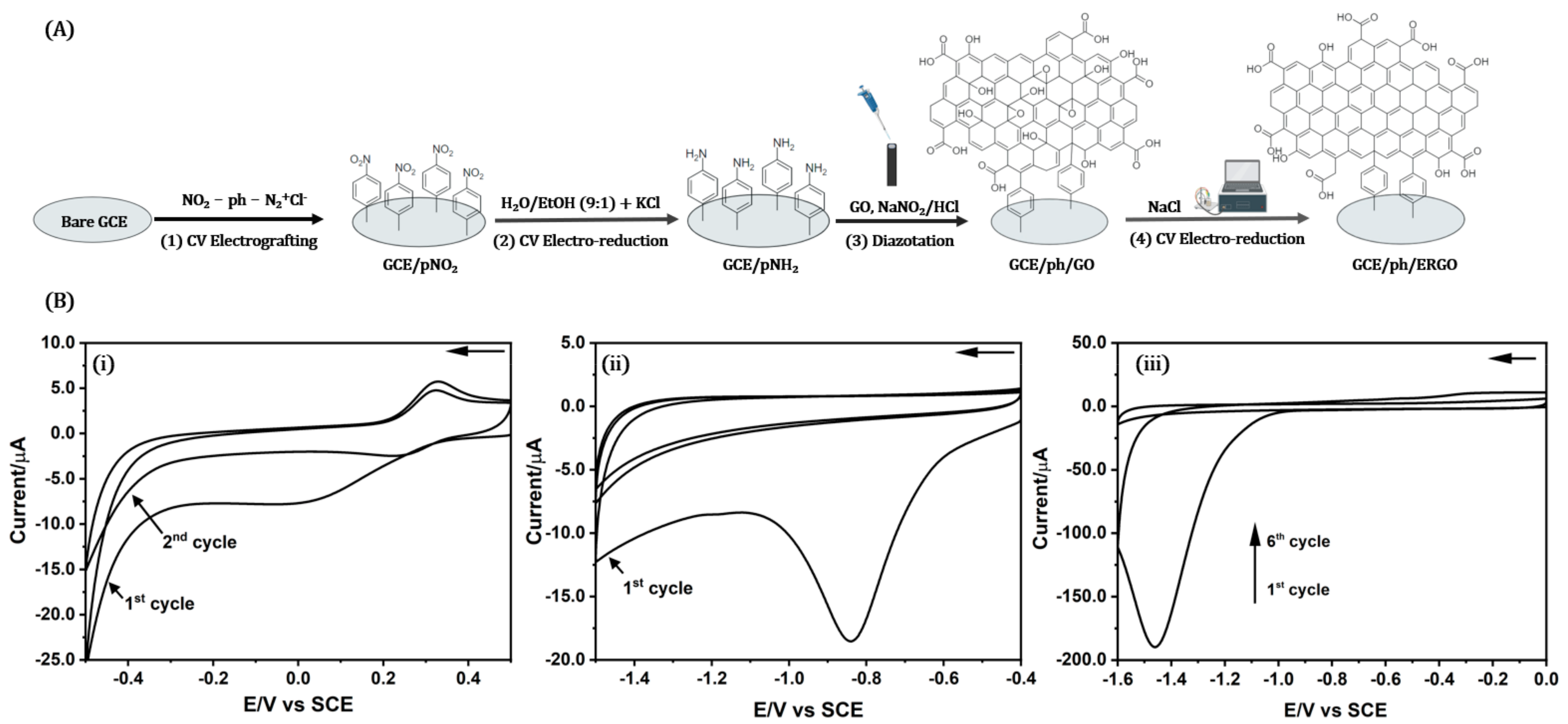
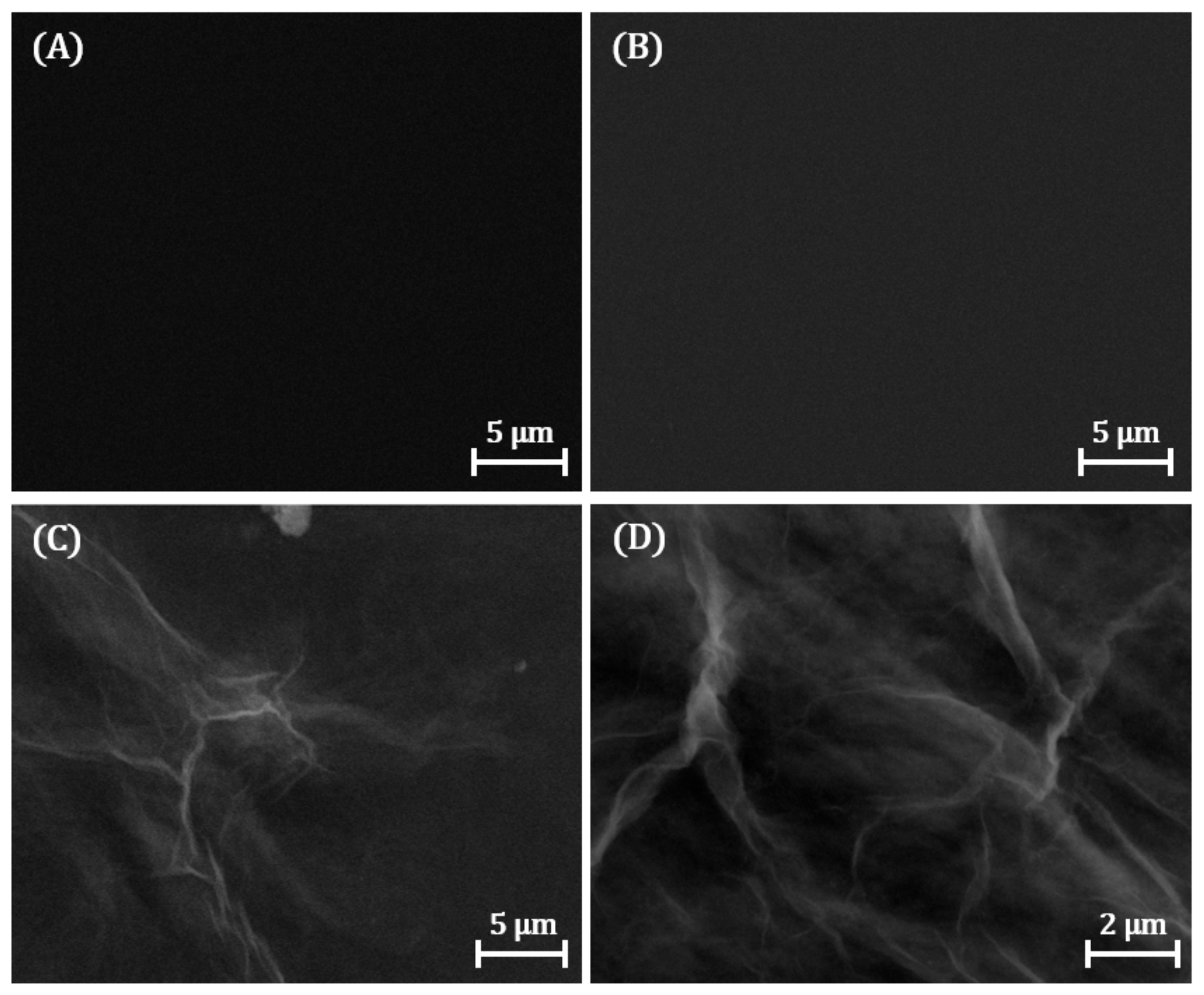

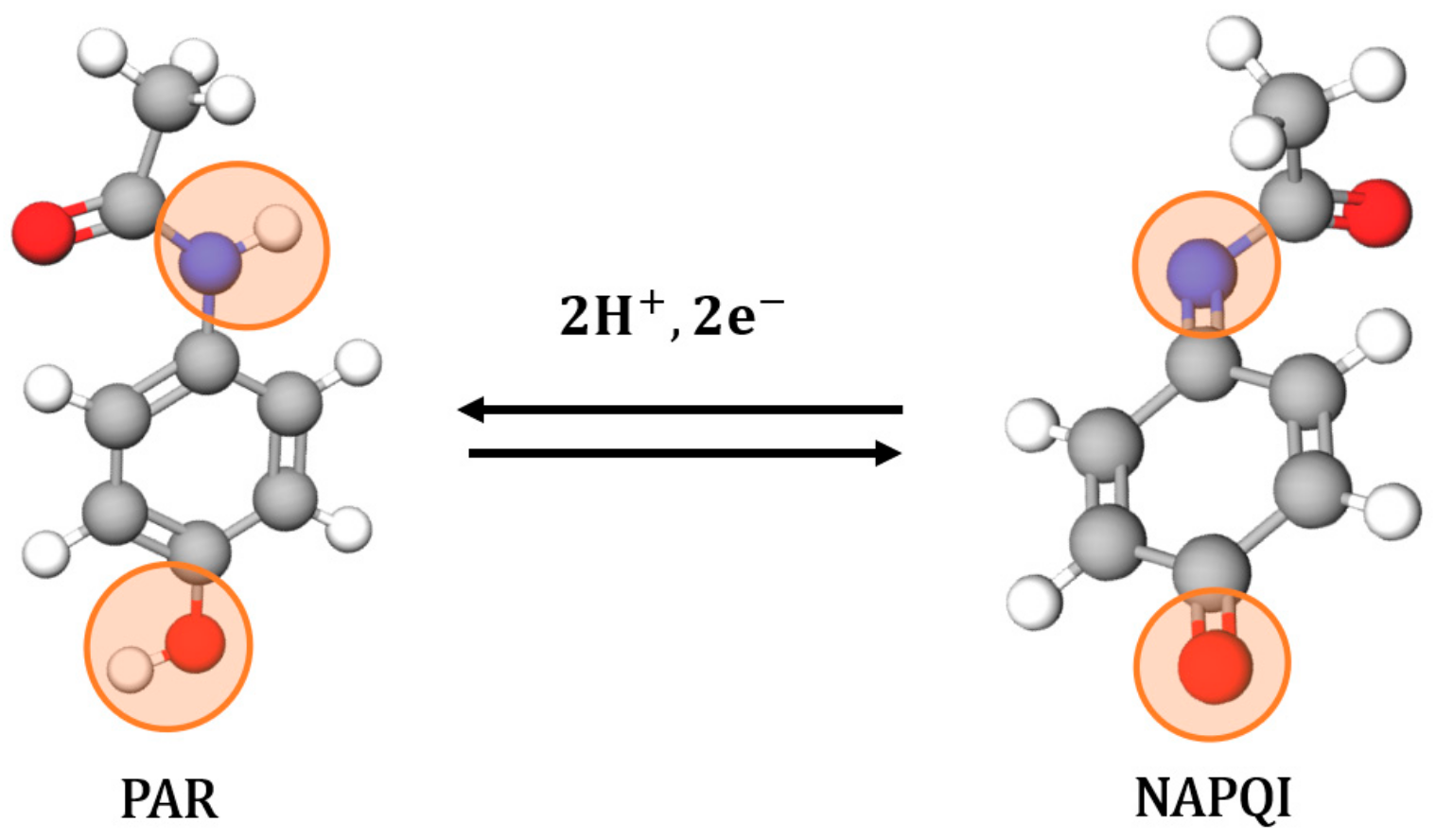
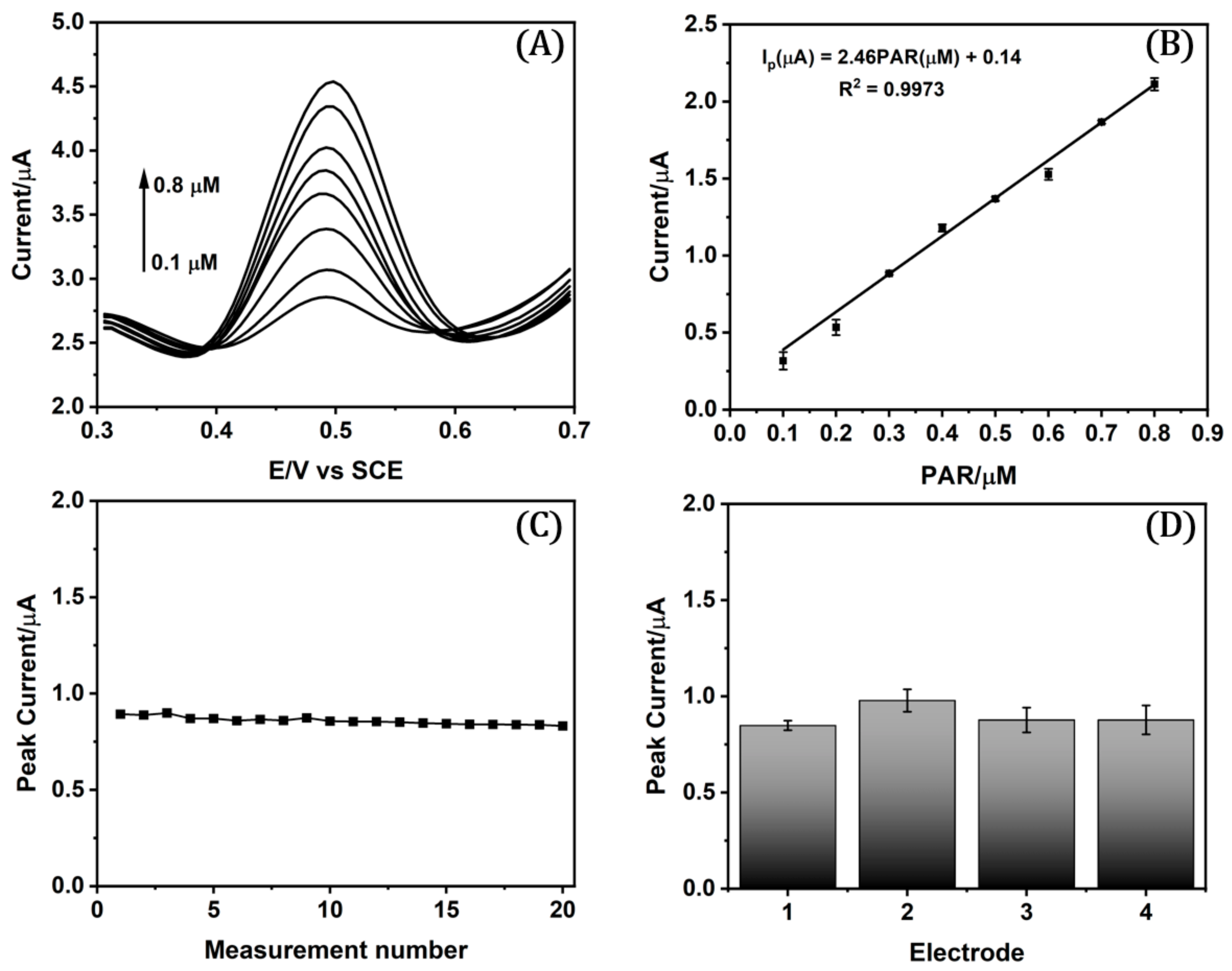
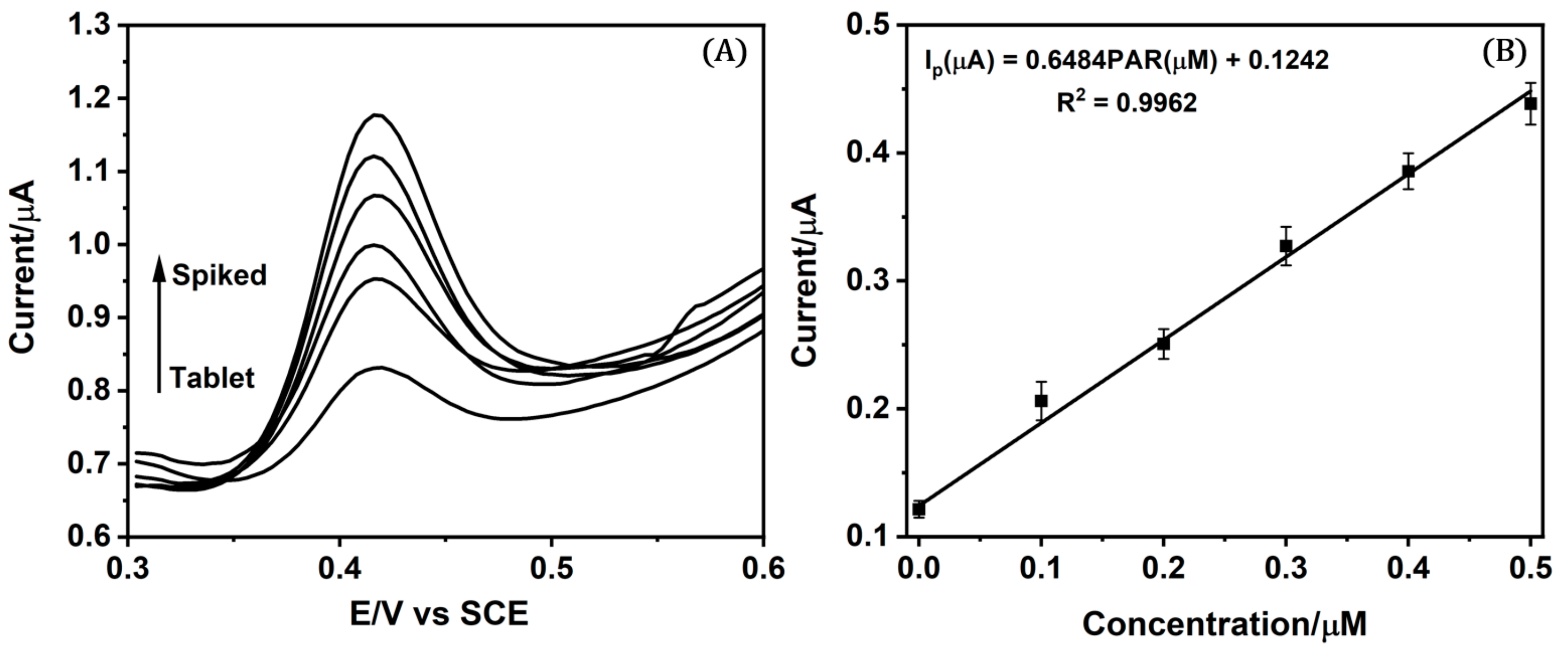
| Sensor | Matrix | Method | Linear Range (μM) | LOD (μM) | Ref |
|---|---|---|---|---|---|
| ZnNC-ERGO | Water | DPV | 0.50–70 | 0.077 | [76] |
| GCE/NGr | Tablet | AMP | 0.10–100 | 3.030 | [77] |
| GCE/3DCN-NF | Tablet | DPV | 0.50–2 | 0.030 | [78] |
| GCE/Poly(Thr)/GO/MWCNT | Tablet Serum | DPV | 5–200 | 0.160 | [79] |
| SPCE/AgNPs/MWCNT | Tablet Water | SWV | 0.50–400 | 0.240 | [80] |
| CPE/MMTk10 | Tablet | DPV | 1–15 | 0.460 | [81] |
| CPE/ERGO/AgNPs | Tablet | CV | 0.10–10 | 0.015 | [82] |
| GCE/gCN-AgPVP | Tablet | SWV | 0.20–100 | 0.079 | [83] |
| GCE/S@ERGO | Tablet | DPV | 0.05–125 | 0.070 | [84] |
| GCE/CuO/O-MWCNT | Tablet | LSV | 0.060–1450 | 0.007 | [59] |
| GCE/ph/ERGO | Tablet | SWV | 0.10–0.80 | 0.018 | This work |
| Method | Labeled Amount (mM) | Found Amount (mM) | Recovery (%) |
|---|---|---|---|
| GCE/ph/ERGO electrode | 5896.18 | 6212.23 | 105 |
| HPLC analysis | 5896.18 | 5765.70 | 98 |
Disclaimer/Publisher’s Note: The statements, opinions and data contained in all publications are solely those of the individual author(s) and contributor(s) and not of MDPI and/or the editor(s). MDPI and/or the editor(s) disclaim responsibility for any injury to people or property resulting from any ideas, methods, instructions or products referred to in the content. |
© 2025 by the authors. Licensee MDPI, Basel, Switzerland. This article is an open access article distributed under the terms and conditions of the Creative Commons Attribution (CC BY) license (https://creativecommons.org/licenses/by/4.0/).
Share and Cite
Paz de la vega, A.; Liendo, F.; Pichún, B.; Penagos, J.; Segura, R.; Aguirre, M.J. Electrochemically Reduced Graphene Oxide Covalently Bound Sensor for Paracetamol Voltammetric Determination. Int. J. Mol. Sci. 2025, 26, 4267. https://doi.org/10.3390/ijms26094267
Paz de la vega A, Liendo F, Pichún B, Penagos J, Segura R, Aguirre MJ. Electrochemically Reduced Graphene Oxide Covalently Bound Sensor for Paracetamol Voltammetric Determination. International Journal of Molecular Sciences. 2025; 26(9):4267. https://doi.org/10.3390/ijms26094267
Chicago/Turabian StylePaz de la vega, Amaya, Fabiana Liendo, Bryan Pichún, Johisner Penagos, Rodrigo Segura, and María Jesús Aguirre. 2025. "Electrochemically Reduced Graphene Oxide Covalently Bound Sensor for Paracetamol Voltammetric Determination" International Journal of Molecular Sciences 26, no. 9: 4267. https://doi.org/10.3390/ijms26094267
APA StylePaz de la vega, A., Liendo, F., Pichún, B., Penagos, J., Segura, R., & Aguirre, M. J. (2025). Electrochemically Reduced Graphene Oxide Covalently Bound Sensor for Paracetamol Voltammetric Determination. International Journal of Molecular Sciences, 26(9), 4267. https://doi.org/10.3390/ijms26094267







